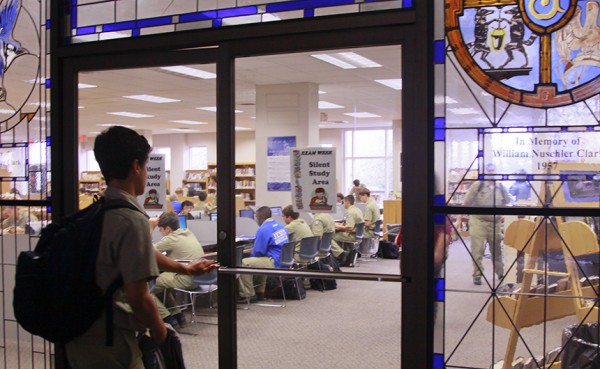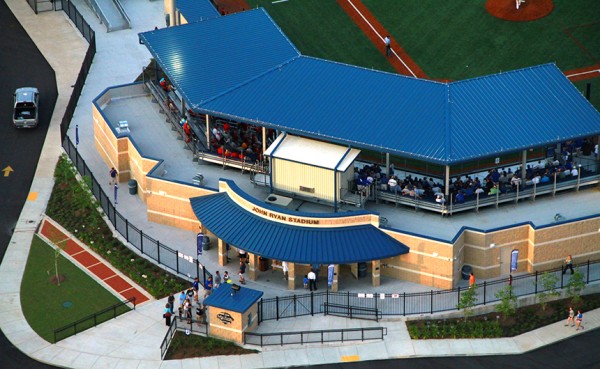History
College of the Immaculate Conception
The present Jesuit High School was formerly only one department of the College of the Immaculate Conception which was founded in 1847 by the Fathers of the Society of Jesus (the Jesuits) for the education of young men.
The College was situated on Baronne and Common Streets; but at the close of the 1910 – 1911 session, the collegiate departments were transferred to the site of the present Loyola University of New Orleans. The high school department, however, was retained in the buildings on Baronne Street. This change was the result of a large increase in enrollment in both the college and the high school departments.
Carrollton & Banks
Increased enrollment again rendered the Baronne Street facilities inadequate. In the fall of 1926, classes met in the newly constructed Jesuit High School on Carrollton Avenue between Banks and Palmyra Streets. An extension of the Palmyra Street wing was completed in 1953 and the improvements provided students with additional space for the cafeteria, library, and band room, along with a new auditorium and chapel. The large chapel was named the Chapel of the North American Martyrs, in honor of the many Jesuits who sacrificed their lives while teaching and spreading the Gospel of Jesus Christ.
A recreation center and gym was constructed on Banks Street across from the school in 1957 and provided facilities for the athletic teams and the physical education program. A spacious Resource Center, featuring the library, additional classrooms, and science facilities was built in 1974. The Resource Center, located opposite the main entrance on Carrollton Avenue, was constructed in response to increased enrollment and further individualization of instruction.
In 1982 four floors of the Jesuits’ residence on Banks Street were renovated, a project which added 10 classrooms and provided new offices for the administration and staff. A year later the cafeteria was enlarged. A new physical education facility — the Louis J. Roussel, Jr. Building — was constructed in 1986 adjacent to the existing gym and included classrooms, athletic meeting rooms, and offices for coaches.
Meanwhile, properties that were part of the entire square block behind the school — bordered by S. Solomon, Banks, S. Hennessy, and Palmyra Streets — had been methodically acquired over a period of some 25 years. The final parcel was purchased in 2001 and Jesuit converted the entire block into a grass athletic field for team practices, P.E. classes, and other events. This open space was dedicated in 2005 as the Will Clark Field.
Tradition Guides Our Future
A central air conditioning and heating system was installed in 2001 throughout much of the school as part of a $10 million capital campaign — Tradition Guides Our Future. This multi-year campaign resulted in vast improvements to the school’s physical plant, including the Jesuit Auditorium and the Cafeteria. The Traditions Campaign paid for new construction of three large computer labs, five science labs, a dozen classrooms, and renovations to modernize the school’s old chemistry and physics labs.
When the Resource Center was constructed over a section of the yard back in 1974, the open area underneath it remained exposed for almost three decades to predictable weather — summer heat and humidity, and winter fog and occasional freezes. Two of the most important projects of the Traditions Campaign involved construction of attractive balcony walkways overlooking the yard and closing in the open area underneath the Resource Center, and in the process installing flooring and air-conditioning (and heating).
The result was the Student Commons — a popular gathering area in the heart of the school’s campus. At all times of the day, students populate the Commons, not only to study, eat lunch, converse, and play cards, but also to check out the action on the large digital monitors that are usually tuned to sports and news channels. The Student Commons is also an attractive setting for Blue Jay alumni reunions during spring and summer weekends.
One of the final Tradition projects was completed in the summer of 2005. Construction of a beautiful Courtyard featured engraved pavers purchased by alumni and parents, attractive landscaping, and additional lighting and seating areas. The project was completed in the days before Hurricane Katrina.
Hurricane Katrina
In the aftermath of Katrina and the collapse of sections of flood walls alongside three important drainage canals, 82% of New Orleans flooded, including Jesuit. The first floor of the school, including the freshly renovated Auditorium, Cafeteria, and Student Commons, and the athletic facilities across Banks Street, sustained catastrophic damage that resulted from five feet of water that inundated the neighborhood. Three weeks after Katrina, Jesuit started the arduous process of emergency remediation, cleaning, and rebuilding. Jesuit also promptly established two satellite schools for hundreds of displaced Blue Jays. The first satellite school was set up at Strake Jesuit in Houston and was attended by more than 400 Blue Jays. A second satellite school was opened in October 2005 at St. Martin’s Episcopal School in Metairie. On November 28, 2005 — the Monday after Thanksgiving and 90 days after Katrina — Jesuit reopened, the first high school that flooded in Orleans Parish to do so. Extensive repairs and renovation of Jesuit’s damaged facilities were finally completed in 2007.
During the summer of 2007, Jesuit renovated a science lab and repaved the entire school yard. “Sympodiums” were set up in all classrooms and continue to offer a variety of technology and media that enhance the learning experience for teachers and students. Several renovation and maintenance projects were completed during the summer of 2008, including a beautiful restoration of St. Ignatius Hall on the third floor of the administration building.
In spring and summer of 2009, the school’s original cypress windows were replaced (except those located on the first floor) with solar-cool bronze windows that are hurricane-impact rated to withstand winds of 130 miles per hour. The windows significantly reduce Jesuit’s energy consumption and the school’s energy bill. Additionally, Jesuit spruced up the external perimeter of the school with fresh landscaping. The school also expanded the parking area in the lot next to the physical education building on Banks Street. Jesuit recently expanded its beautification project to the Carrollton Avenue and Banks Street neutral grounds where numerous light poles display attractive blue and white banners that depict familiar staples of Jesuit teaching: “Men of Faith,” “Men for Others,” and A.M.D.G.
John Ryan Stadium Opens
The weekend of March 2-4, 2012 marked an important athletic milestone for Jesuit High School — the grand opening of John Ryan Stadium, the school’s first off-campus multi-sport facility and practice field located five minutes from Jesuit, off Airline Drive just over the Orleans-Jefferson Parish border. The main entrance to this $8 million smoke and alcohol-free facility is via an old street bearing a new name — Blue Jay Way. John Ryan Stadium’s covered grandstand accommodates 622 fans and sideline bleachers seat 680 people. A covered pavilion adjacent to the Blue Jays’ dugout is the ideal gathering spot for any number of Jesuit events, including alumni class reunions, tailgating parties, and even the weigh-in festivities for the annual fishing rodeo. The stadium and field serve as the home of Jesuit’s varsity and sub-varsity baseball, soccer, rugby, and lacrosse teams. The sub-varsity football teams will play their home games at John Ryan Stadium. While the varsity football team will hold practices at the facility, Tad Gormley Stadium in City Park will continue to be used whenever Jesuit is the home team. John Ryan Stadium is one of the finest prep sports complexes in the country, and for the first time, Blue Jay athletes are enjoying the “Home Field Advantage.”
Despite growth and change throughout its history, Jesuit High School of New Orleans remains committed to its founding principles of superior educational and spiritual growth of the of the individual – the hallmark of a deeply rooted in a Jesuit philosophy spanning nearly five hundred years. The founder of the Jesuits, Saint Ignatius of Loyola (1491-1556) continues to inspire us.

